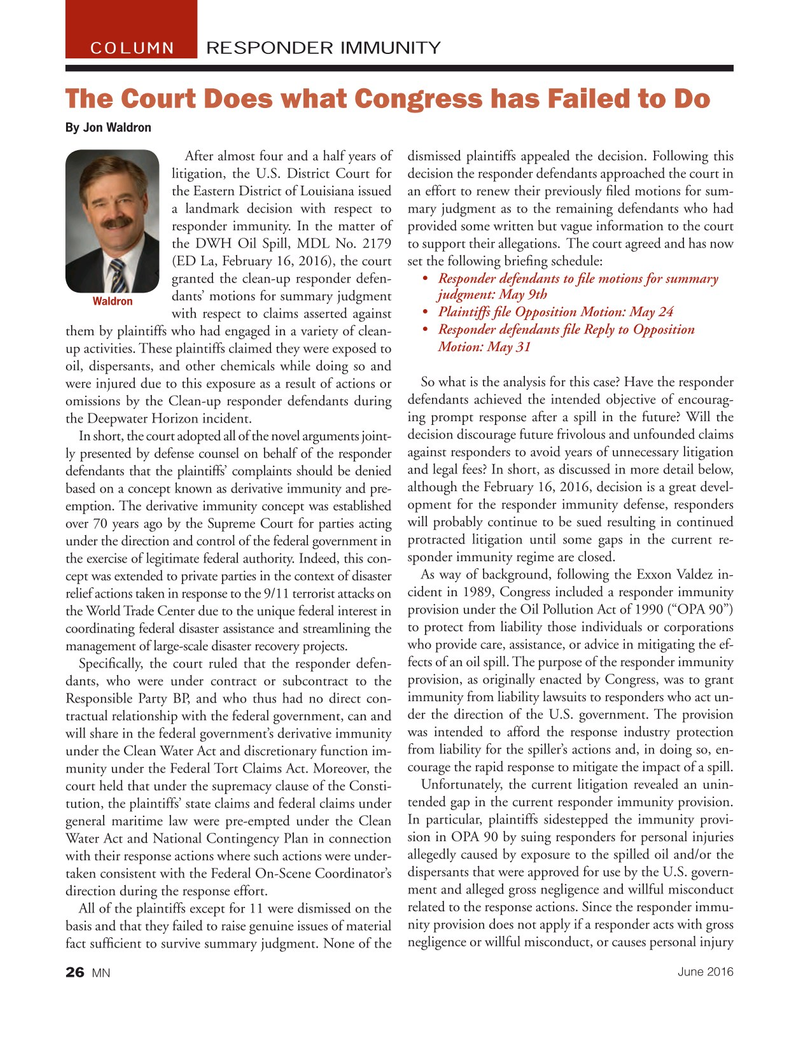
Page 26: of Marine News Magazine (June 2016)
Combat & Patrol Craft Annual
Read this page in Pdf, Flash or Html5 edition of June 2016 Marine News Magazine
COLUMN RESPONDER IMMUNITY
The Court Does what Congress has Failed to Do
By Jon Waldron
After almost four and a half years of dismissed plaintiffs appealed the decision. Following this litigation, the U.S. District Court for decision the responder defendants approached the court in the Eastern District of Louisiana issued an effort to renew their previously ? led motions for sum- a landmark decision with respect to mary judgment as to the remaining defendants who had responder immunity. In the matter of provided some written but vague information to the court the DWH Oil Spill, MDL No. 2179 to support their allegations. The court agreed and has now (ED La, February 16, 2016), the court set the following brie? ng schedule: granted the clean-up responder defen- • Responder defendants to ? le motions for summary dants’ motions for summary judgment judgment: May 9th
Waldron • Plaintiffs ? le Opposition Motion: May 24 with respect to claims asserted against • Responder defendants ? le Reply to Opposition them by plaintiffs who had engaged in a variety of clean- up activities. These plaintiffs claimed they were exposed to Motion: May 31 oil, dispersants, and other chemicals while doing so and
So what is the analysis for this case? Have the responder were injured due to this exposure as a result of actions or omissions by the Clean-up responder defendants during defendants achieved the intended objective of encourag- ing prompt response after a spill in the future? Will the the Deepwater Horizon incident. decision discourage future frivolous and unfounded claims
In short, the court adopted all of the novel arguments joint- ly presented by defense counsel on behalf of the responder against responders to avoid years of unnecessary litigation defendants that the plaintiffs’ complaints should be denied and legal fees? In short, as discussed in more detail below, although the February 16, 2016, decision is a great devel- based on a concept known as derivative immunity and pre- emption. The derivative immunity concept was established opment for the responder immunity defense, responders over 70 years ago by the Supreme Court for parties acting will probably continue to be sued resulting in continued under the direction and control of the federal government in protracted litigation until some gaps in the current re- sponder immunity regime are closed. the exercise of legitimate federal authority. Indeed, this con-
As way of background, following the Exxon Valdez in- cept was extended to private parties in the context of disaster relief actions taken in response to the 9/11 terrorist attacks on cident in 1989, Congress included a responder immunity the World Trade Center due to the unique federal interest in provision under the Oil Pollution Act of 1990 (“OPA 90”) coordinating federal disaster assistance and streamlining the to protect from liability those individuals or corporations who provide care, assistance, or advice in mitigating the ef- management of large-scale disaster recovery projects. fects of an oil spill. The purpose of the responder immunity
Speci? cally, the court ruled that the responder defen- dants, who were under contract or subcontract to the provision, as originally enacted by Congress, was to grant immunity from liability lawsuits to responders who act un-
Responsible Party BP, and who thus had no direct con- tractual relationship with the federal government, can and der the direction of the U.S. government. The provision will share in the federal government’s derivative immunity was intended to afford the response industry protection from liability for the spiller’s actions and, in doing so, en- under the Clean Water Act and discretionary function im- munity under the Federal Tort Claims Act. Moreover, the courage the rapid response to mitigate the impact of a spill.
Unfortunately, the current litigation revealed an unin- court held that under the supremacy clause of the Consti- tution, the plaintiffs’ state claims and federal claims under tended gap in the current responder immunity provision. general maritime law were pre-empted under the Clean In particular, plaintiffs sidestepped the immunity provi-
Water Act and National Contingency Plan in connection sion in OPA 90 by suing responders for personal injuries allegedly caused by exposure to the spilled oil and/or the with their response actions where such actions were under- taken consistent with the Federal On-Scene Coordinator’s dispersants that were approved for use by the U.S. govern- ment and alleged gross negligence and willful misconduct direction during the response effort.
All of the plaintiffs except for 11 were dismissed on the related to the response actions. Since the responder immu- basis and that they failed to raise genuine issues of material nity provision does not apply if a responder acts with gross fact suf? cient to survive summary judgment. None of the negligence or willful misconduct, or causes personal injury
June 2016
MN 26
MN June16 Layout 18-31.indd 26 5/17/2016 11:03:19 AM

 25
25

 27
27
